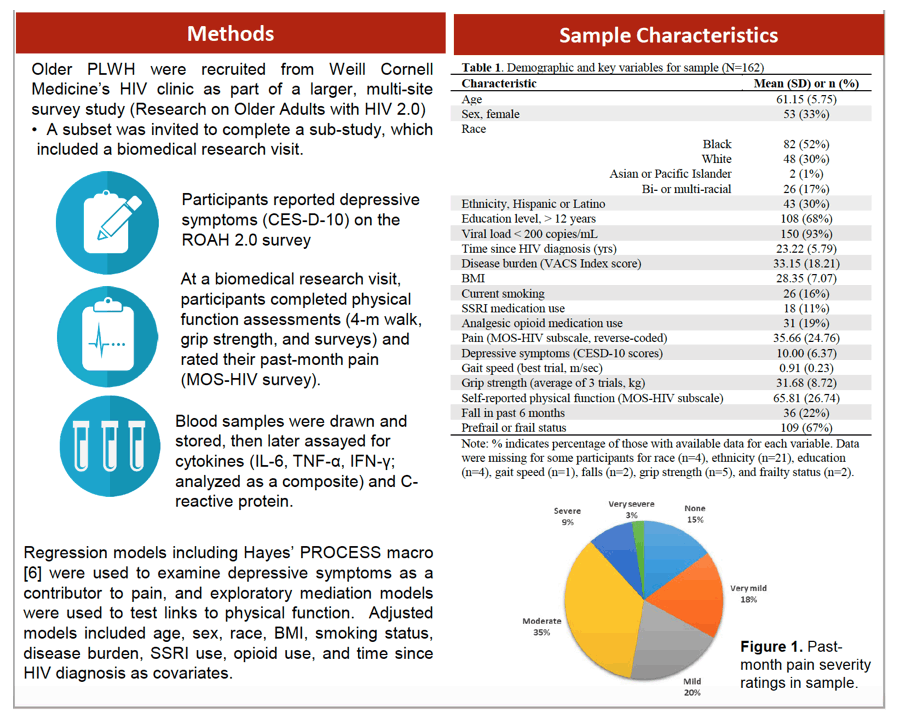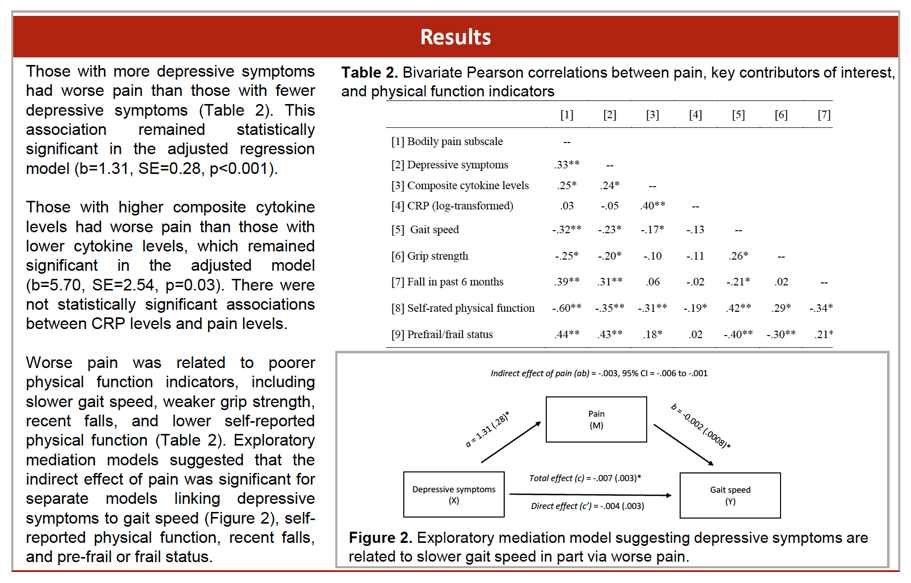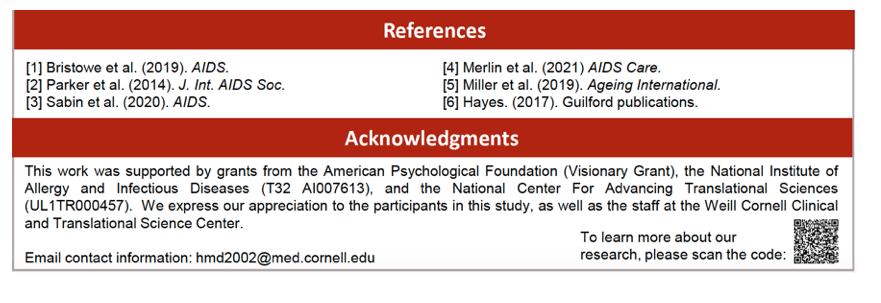 |
 |
 |
| |
Pain Linked to Depression, Worse Physical Function, Falls, Frailty and Inflammation in Older People With HIV
|
| |
| |
International Workshop on HIV and Aging, September 23-24, 2021
By Mark Mascolini for NATAP and Virology Education
Pain may be an underlying factor or pathway linking depressive symptoms and inflammation to age-related health problems in older people with HIV, according to results of a 162-person study at Weill Cornell Medicine in New York City [1]. While 12% of this HIV group reported severe or very severe pain, 35% had moderate pain.
With colleague at other centers, the Weill Cornell group noted that people with HIV often experience both chronic pain and depression. They explored relationships between depressive symptoms and pain then assessed the contribution of pain to worse physical function and inflammation in older people with HIV.
At the Weill Cornell HIV clinic, researchers invited a subset of people recruited for a multicenter study of older people with HIV to participate in a substudy of depression, pain, and physical function. At one visit people reported depressive symptoms on the ROAH 2.0 survey. At a second visit they rated past-month pain on the MOS-HIV survey and had physical function assessments including a 4-meter walk and grip strength. Researchers analyzed blood samples for cytokines (IL-6, TNF-alpha, IFN-gamma) and the inflammation marker C-reactive protein. They used regression models to explore potential contributions of depressive symptoms to pain, and they used mediation models to test links to physical function. Adjusted models considered age, sex, race, body mass index (BMI), smoking status, disease burden, SSRI (antidepressant) use, opioid use, and time since HIV diagnosis.
The study group averaged 61 years in age, 33% were women, 52% black, 30% white, 1% Asian or Pacific Islander, and the rest multiracial; 30% were Hispanic. Two thirds of the group had more than 12 years of education, 93% had a viral load below 200 copies, and time since HIV diagnosis averaged 23 years. Group body mass index averaged 28.35 kg/m2, putting them in the overweight range. While 19% of participants used an opioid analgesic medication, 11% took an SSRI antidepressant. Two thirds were prefrail or frail. While 3% reported very severe pain in the past month, 9% had severe pain, 35% moderate pain, 20% mild pain, 18% very mild pain, and 15% no pain.
Adjusted regression analysis determined that people with more depressive symptoms had worse pain than people with fewer depressive symptoms (b = 1.31, SE = 0.28, P < 0.001). Adjusted analysis also linked higher composite cytokine levels to worse pain (b = 5.70, SE = 2.54, P = 0.03). C-reactive protein was not associated with pain level.
Bivariate Pearson correlations tied worse pain to worse physical function indicated by slower gait speed, weaker grip strength, recent falls, and lower self-reported physical function. Exploratory mediation models suggested that pain may partly explain the link between depressive symptoms and certain physical function outcomes: gait speed, self-reported physical function, recent falls, and prefrailty or frailty.
Worse pain was related to poorer physical function indicators, including slower gait speed, weaker grip strength, recent falls, and lower self-reported physical function (Table 2). Exploratory mediation models suggested that the indirect effect of pain was significant for separate models linking depressive symptoms to gait speed (Figure 2), self-reported physical function, recent falls, and pre-frail or frail status.
The researchers believe their findings “suggest that depressive symptoms and inflammation are linked to pain” in older people with HIV and that these relationships probably have an impact on physical function. Looking at their results from the pain perspective, they proposed that pain may be an “underlying factor and/or pathway linking depressive symptoms and inflammation to age-related health vulnerabilities” in older people with HIV.
The Weill Cornell group added that people with HIV are often open to multidisciplinary approaches to pain management, such as behavioral health and geriatric medicine protocols.
Reference
1. Derry H, Johnston C, Brennan-Ing M, et al. Relationships between depressive symptoms, pain, and physical function in older adults with HIV. International Workshop on HIV and Aging, September 23-24, 2021. Abstract 22.





|
| |
|
 |
 |
|
|